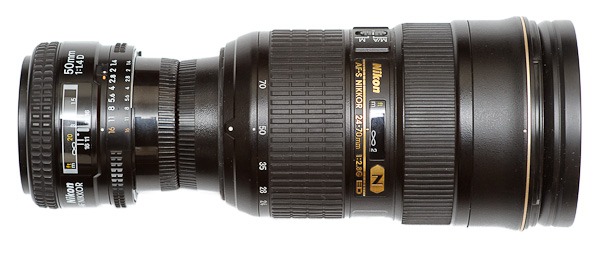The eternal dichotomies. Good vs Evil. Night vs Day. Nikon vs Canon. Primes vs Zooms.
When it comes to available light event photography, the photographer is often pulled between constraints – the two biggest of which are limited access and limited lighting. As a result, we're also often split between the solutions to these problems as well – the flexible framing of zoom lenses and the raw, low-light speed of prime lenses.
Whether you're shooting weddings, concerts or any other situation where shooting position and light are constrained, here's a look at the benefits and limitations of primes and zooms for event photography.
Prime Lenses
Pros:
In the contemporary landscape of computer-designed optics, where even consumer zooms can deliver some amazing results, the chief advantage of prime lenses for is their speed. All but super telephoto primes are at least one if not two times faster than zoom lenses covering the same focal range. Even with the best DSLRs, the difference of two stops can mean the difference between shooting at a camera's high ISO sweet spot and looking at a sea of digital noise.
Moreover, prime lenses give photographers the flexibility to use lower ISO sensitivities, high shutter speeds, or shoot in lower light than their variable focal length peers – sometimes all three at once. In the lowest light, a prime shooter can happily click away in conditions that has zooms users crying in the dark.
Moreover, a prime lens like the ubiquitous 50mm f/1.8 available for all systems is often one of the most inexpensive lenses one can buy, offering image quality and speed at a fraction of a f/2.8 zoom's price.
On the other end of the price spectrum, it's also worth noting that super telephoto primes also offer reach in addition to speed that zooms just can't touch. For situations like sports where extreme distances necessitate teleconverters for maximum effect, the benefit of a fast prime lens is even more evident.
Cons:
The major downside of prime lenses for event photography is that their fixed focal length nature directly compounds the limited access and/or viable shooting positions for any given event and moment. This is particularly true for live music photography, with shooting often limited to the front of the stage for credentialed press in potentially crowded photo pits, but is essentially true for weddings and other event shooting as well.
At best, the inflexibility of prime lenses present limitations that foster creative solutions. At worst, the result is awkward and ineffective compositions.
In addition, for anyone shooting a single DSLR body, prime lenses may feel especially limiting for fast movement and situations where the positions of the performers changes rapidly. Using prime lenses may necessitate more frequent lens changes as well.
Zoom Lenses
Pros:
Zoom lenses are all about flexibility. With the already heavy constraints of live music photography, the ability to fluidly frame and execute compositions and different perspectives is a huge asset to the event shooter. This point is especially true when one is shooting in a crowded photo pit, when multiple photographers jockeying for position limits available angles even more, or at a crowded event with limited options for clean sight lines.
For event photography in general, zoom lenses can allow for the precise framing even in non-ideal shooting situations where the luxury to choose one's precise position is not always an option.
Aside from exact composition, the sheer ability to dramatically change perspectives with a zoom lens – going from wide-angle to telephoto in the case of a midrange zoom – is a huge asset for quickly-moving action.
A perfect example for the flexibility of a zoom is shooting a performer who may be behind a mic stand or monitors who then quickly comes to front of the stage. A midrange zoom transitions effortlessly in this situation that would otherwise leave a prime lens floundering.
Cons:
For concert photography, the downside to zoom lenses comes in their relatively slow maximum apertures, which clock in at f/2.8 at the fastest for most manufacturers. This limitation puts them two-stops a good f/1.4 prime, which is capable of letting in four times as much light. Needless to say, when the light levels drop, zooms are at a huge disadvantage against faster primes even with the excellent high ISO performance of current DSLRs.
To a lesser degree, optical quality can be an issue with non-pro grade zooms as well.
The Solution
A Mixed Bag
The obvious solution to the speed of primes and the flexibility of zoom lenses? Use them both. My kit includes a core set of zoom lenses covering 14mm to 200mm at f/2.8, as well as 50mm f/1.4 and 85mm f/1.4 primes for the lowest light.
My Kit
Primes:
Between the 50mm f/1.4 and 85mm f/1.4, there's a lot of super usable range. I always find the 50mm f/1.4 especially nice for waist-up shots of guitarists, where it's often the perfect frame for including the entire guitar. Add a Nikon 24mm f/1.4 or Nikon 35mm f/1.4 to this kit and you're set.
Zooms:
In terms of range, these three lenses cover just about anything and everything, from the ultra-wide at 14mm to drummer shots at 200mm. The Nikon 24-70mm f/2.8 and 70-200mm f/2.8 are especially utilitarian for live music and general event photography.
Summary
For me, the utility of zooms is undeniable, and with modern formulas and optics, the performance is never in question. In fact, I prefer my f/2.8 zooms for AF precision and speed. However, the ability of my f/1.4 primes to shoot in even the poorest light secures their place in my bag.
By mixing primes and zooms, the music photographer is covered for everything from blazing arena shows to small, dimly lit clubs. Unless you get a profound sense of satisfaction by shooting exclusively with one set of lenses or another, a mixed bag provides the best of both worlds.








